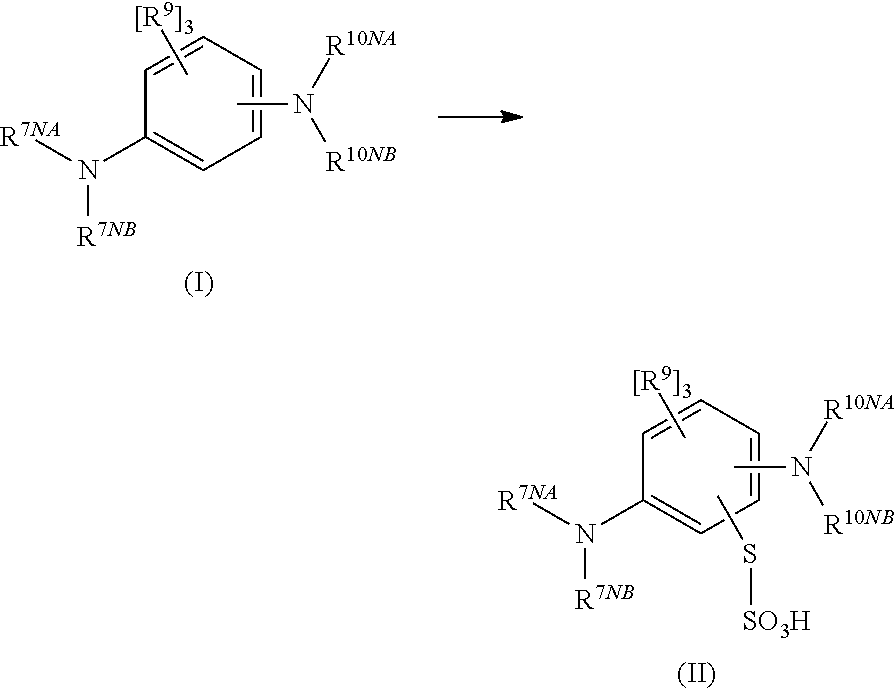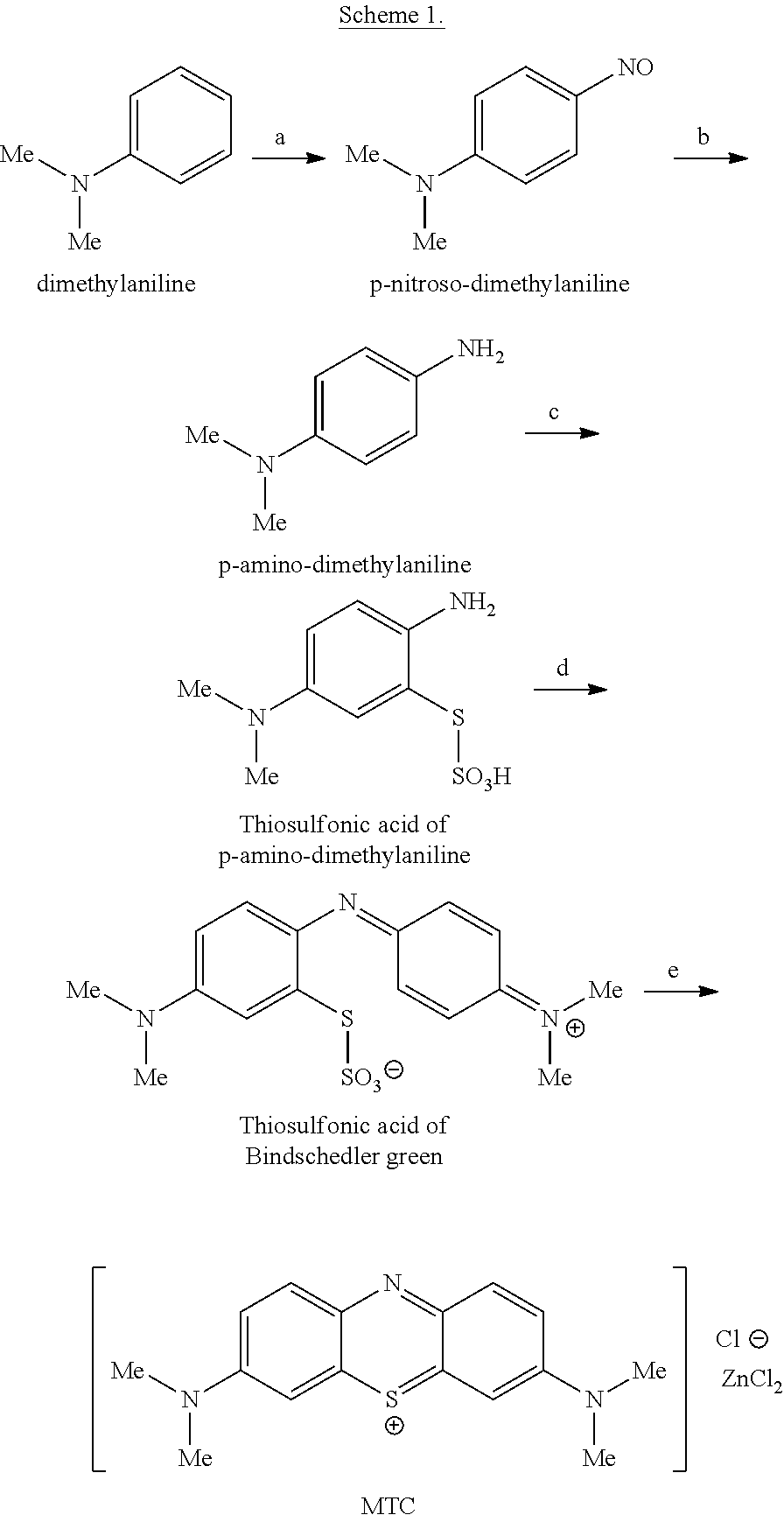Methods of chemical synthesis of diaminophenothiazinium compounds involving the use of persulfate oxidants
a diaminophenothiazinium and chemical synthesis technology, applied in the field of chemical synthesis and purification, can solve the problems of inability to use a large scale technique, inconvenient quantification, and inability to meet the requirements of mtc purification,
- Summary
- Abstract
- Description
- Claims
- Application Information
AI Technical Summary
Benefits of technology
Problems solved by technology
Method used
Image
Examples
embodiments
[0058]The following embodiments may apply to each of the compounds described herein, as appropriate.
[0059]Alkyl and Alkenyl Groups
[0060]In one embodiment, the C1-4alkyl groups are selected from: linear C1-4alkyl groups, such as -Me, -Et, -nPr, -iPr, and -nBu; branched C3-4alkyl groups, such as -iPr, -iBu, -sBu, and -tBu; and cyclic C3-4alkyl groups, such as -cPr and -cBu.
[0061]In one embodiment, the C2-4alkenyl groups are selected from linear C1-4alkenyl groups, such as —CH═CH2 (vinyl) and —CH2—CH═CH2 (allyl).
[0062]In one embodiment, the halogenated C1-4alkyl groups are selected from: —CF3, —CH2CF3, and —CF2CF3.
[0063]Aryl and Alkylenearyl Groups
[0064]In one embodiment, the C5-10aryl groups are selected from C6-10carboaryl groups, such as phenyl or napthyl, and C5-10heteroaryl groups, such as thienyl, imidazolyl, pyrazolyl, triazolyl, oxazolyl, isoxazolyl, thiazolyl, isothiazolyl, pyridyl, pyrimidinyl or quinolinyl.
[0065]In one embodiment, the halogenated C5-10aryl groups are selecte...
example 3
[0748]N′,N′-dimethyl-p-phenylene diamine (5 g, 0.036 mols) was added to a round bottom flask. To this was added de-ionised water (80 ml) and acetonitrile (20 ml) and the solution was then cooled to 5° C. Sodium thiosulfate (10.03 g, 0.040 mols) in water (20 ml) was added to the solution in one aliquot. Sodium persulfate (8.75 g, 0.036 mols) in water (40 ml) was added drop-wise over a 15 minute period. The reaction mixture was stirred for 3 hours at 5° C. and then warmed to 22° C. over a period of 1 hour. The black solid which precipitated was collected via filtration. The black solid was washed with water (50 ml) then dried under vacuum (1000 mbar) at 40° C. for 16 hours. N′,N′-dimethyl-p-phenylene diamine-5-thiosulfonic acid was added to a round bottom flask and ethyl acetate (100 ml) was added. The slurry was heated to reflux for one hour and then cooled to a temperature between 18-22° C. Once the slurry had cooled to the desired temperature the purple solid was collected via filt...
example 4
[0753]N,N′-dimethyl-p-phenylene diamine (5 g, 0.036 mols) was added to a round bottom flask. To this was added de-ionised water (80 ml) and N,N-dimethylformamide (20 ml) and the solution was then cooled to 5° C. Sodium thiosulfate (10.03 g, 0.040 mols) in water (20 ml) was added to the solution in one aliquot. Sodium persulfate (8.75 g, 0.036 mols) in water (40 ml) was added drop-wise over a 15 minute period. The reaction mixture was stirred for 3 hours at 5° C. and then warmed to 22° C. over a period of 1 hour. The black solid which precipitated was collected via filtration. The black solid was washed with water (50 ml) then dried under vacuum (1000 mbar) at 40° C. for 16 hours. N′,N′-dimethyl-p-phenylene diamine-5-thiosulfonic acid was added to a round bottom flask and ethyl acetate (100 ml) was added. The slurry was heated to reflux for one hour and then cooled to a temperature between 18-22° C. Once the slurry had cooled to the desired temperature the purple solid was collected ...
PUM
| Property | Measurement | Unit |
|---|---|---|
| pH | aaaaa | aaaaa |
| pH | aaaaa | aaaaa |
| pH | aaaaa | aaaaa |
Abstract
Description
Claims
Application Information
 Login to View More
Login to View More - R&D
- Intellectual Property
- Life Sciences
- Materials
- Tech Scout
- Unparalleled Data Quality
- Higher Quality Content
- 60% Fewer Hallucinations
Browse by: Latest US Patents, China's latest patents, Technical Efficacy Thesaurus, Application Domain, Technology Topic, Popular Technical Reports.
© 2025 PatSnap. All rights reserved.Legal|Privacy policy|Modern Slavery Act Transparency Statement|Sitemap|About US| Contact US: help@patsnap.com



